Health Care and Natural Ventilation
Breath of Fresh Air: Hospitals that rely primarily on passive means for cooling offer a new model for healing environments.
![]() Continuing Education
Continuing Education
Use the following learning objectives to focus your study while reading this month’s Continuing Education article.
Learning Objectives - After reading this article, you will be able to:
- Outline the benefits of naturally ventilated health-care facilities.
- Discuss hurdles to implementing natural ventilation in North American health-care facilities.
- Discuss industry standards and regulations pertaining to ventilation in health-care facilities.
- Explain physical phenomena relevant to natural ventilation, such the Venturi effect and stack ventilation.
View course on architecturalrecord.com »
At a scale unheard of in their home country, American architecture firms are using natural ventilation to achieve energy savings, resilience, and patient comfort in two major health-care projects in Asia. At Singapore’s Ng Teng Fong General Hospital (NTFGH), one of this year’s AIA COTE Top Ten Award winners, more than 80 percent of bed spaces are cooled and ventilated relying on passive strategies alone. At XiangYa Hospital, a 5.6 million-square-foot medical facility in Changsha, in south central China, slated to start construction this summer, windows will be the primary source of cooling and ventilation for all patient rooms.

PHOTOGRAPHY: © RORY DANIEL AND CPG CONSULTANTS
MADE IN THE SHADE
The facades of Ng Teng Fong General Hospital (left) in Singapore rely on several types of shading devices. The patient-room wings (right) have deep precast concrete overhangs that support plants. These provide additional shade, evaporative cooling, and views.
Although natural ventilation is common internationally, North Americans are accustomed to full mechanical ventilation, says Travis English, chief design engineer for health-care consortium Kaiser Permanente and a member of a natural-ventilation task group for the American Society of Heating, Refrigerating and Air-Conditioning Engineers (ASHRAE). “So, a naturally ventilated health-care building here is going to be somewhat countercultural,” he says. The few naturally ventilated North American health-care facilities that do exist, such as Peace Island Medical Center, an award-winning facility on San Juan Island, Washington, tend to reflect considerations so specific to their particular circumstances that they reinforce just how unusual natural ventilation in North American health care really is.
So how do international health-care facilities achieve comfortable environments with natural ventilation? And should North Americans expect to see more of such facilities?
From the very beginning, the design priority for the 1.84 million-square-foot NTFGH, which opened in 2015, was to make the patient’s experience far more pleasant, says William Roger, director of health care in the San Francisco office of HOK, architects for the project with CPG Consultants and Studio 505. A pre-design tour of Singapore’s public hospitals found standard, multipatient wards configured so that only the patient at the end of the room had access to a window—and drawing that patient’s privacy curtain blocked access to light and air for patients farther from the building perimeter. Bedside fans only served to circulate increasingly warm air.
To improve the healing environment, airflow was paramount: research has shown that, in tropical climates, higher temperatures (from 79 to 84 degrees Fahrenheit) in rooms with ceiling fans are more comfortable than cooler spaces without them. The design team’s solution opens the floor plan of the standard ward like the wings of a bird, a move that creates a semiprivate corner with its own operable window for each patient bed. The outside walls of the splayed floor plan catch the wind and channel it toward the windows. As the floor plan narrows, air throttles through the tightening spaces in a Venturi effect, which increases air velocity without mechanical intervention. Single-loaded corridors narrow the building depth, promoting more effective cross ventilation and reducing the passage of air across multiple patients. “Even on a calm day,” says Roger, “you can feel a breeze.”
Creating a comfortable temperature in Singapore’s tropical climate using only natural ventilation begins long before the breeze enters the room, however. NTFGH’s facades comprise multiple layers and elements, including vertical sunshades and deep overhangs of precast concrete. In addition to providing shade, the overhangs support plantings that contribute additional shade and some evaporative cooling, as well as views. Facade design is unique to each orientation, providing 60 percent shading on critical facades and 40 percent on others. Critical facades are those for which shading is essential to providing patient comfort or other required conditions. The facade at the patient ward, for example, would be more heavily shaded than the facade adjacent to a corridor. With no need for insulation, the building’s weather envelope consists of inexpensive prefabricated panels supporting two types of windows: upper, operable windows, and lower, hurricane windows with vents that let in air while keeping out wind and rain.
NTFGH’s combined energy conservation strategies achieve a design Energy Use Intensity (EUI)—calculated by dividing the total energy consumed annually by the total gross floor area—of 72 kBtu per square foot per year. This represents a 38 percent reduction compared with a typical Singapore hospital, and a 69 percent reduction compared with a typical U.S. hospital.
While it should be no revelation that natural ventilation and passive cooling help reduce energy consumption, it may be surprising that the strategy also plays a role in conserving water. Because cooling towers are one of the largest consumers of water in fully air-conditioned hospitals—especially in a hot climate like Singapore’s—the use of passive design to condition 70 percent of the building constitutes the facility’s single most effective water-conservation measure.
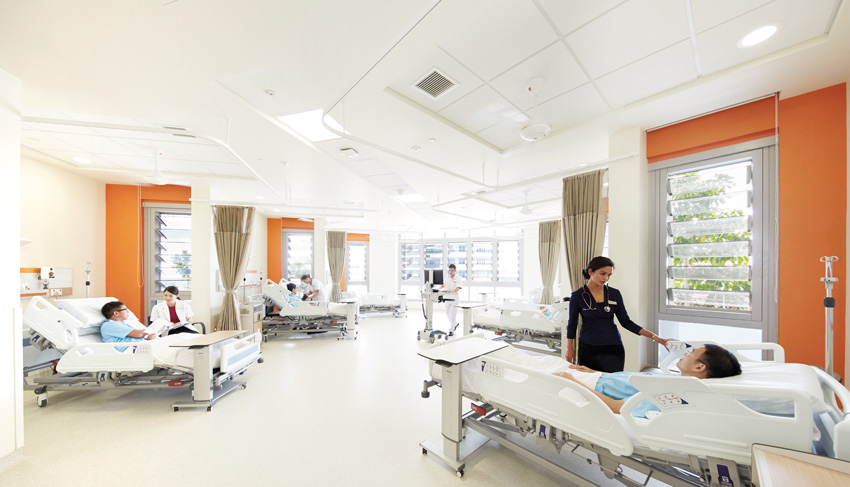
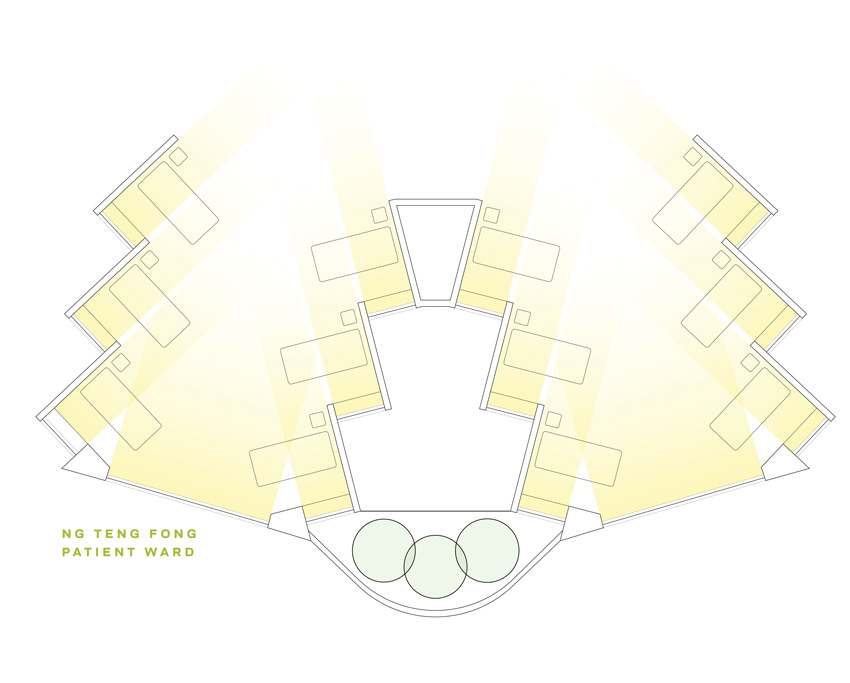
IMAGES: © RORY DANIEL AND CPG CONSULTANTS (TOP); COURTESY HOK (BOTTOM)
FAN PLAN
Multi-bed wards (top and bottom) at Ng Teng Fong in Singapore are shaped like fans. The strategy creates a semi-private corner with its own operable window for each patient and helps promote the Venturi effect and cross ventilation.
In selecting the project as an AIA COTE Top Ten winner, the jury commented that “this project is an extraordinary model for hospitals to behave as healing environments not seen in the United States” and “the passive strategies demonstrated here are a model for hospitals around the world.”
As with NTFGH, the mandate for passive cooling and ventilation at XiangYa Hospital derived from established health-care design practice in the region. “We know how to open windows,” the client told Boston-based Payette Architects in establishing the design parameters for the 2,500-bed facility. “We do not want air-conditioning or any mechanical systems whatsoever in the patient units.” The city’s current hospital is naturally ventilated, and the client expects the new one, which will consist of zigzagging inpatient wings atop orthogonal medical-service podiums, to improve patients’ thermal comfort through a more deliberate approach.
In many ways, Changsha is well suited to natural ventilation. Air quality is not a problem, as it is in many of China’s northern cities, and Changsha’s subtropical climate has four distinct seasons. However, increasingly frequent summer heat waves make it difficult to guarantee comfortable conditions through natural ventilation alone. “We need to design a system to protect the weakest,” says Alejandra Menchaca, a senior building scientist with Payette, “and we couldn’t quite do it with natural ventilation year-round.” The design solution will provide passive conditioning for what’s estimated to be 70 percent of the cooling season, based on adaptive comfort thresholds, and staff will turn on mechanical air-conditioning to moderate peak temperatures. The concept of adaptive comfort recognizes that people feel comfortable across a wider range of indoor temperatures if they have control over window operability. It’s also a function of outdoor temperature: on a hot day, people are comfortable at warmer indoor temperatures, and vice versa.
To move air, natural-ventilation systems rely on pressure differentials, which can be generated either by the wind for cross ventilation (as at NTFGH) or by temperature or humidity differences. In stack ventilation, an example of this, warmer air exits high and draws cooler air in low. This can allow a room to be self-ventilating, taking air in and exhausting it through openings in the same wall. Such is the strategy planned for XiangYa.
In a way, though, the XiangYa design team is fighting with one hand tied behind its back: while the client’s mandate calls for natural ventilation and cooling, it also calls for a building envelope primarily of glass. “It’s an unfortunate trend,” says Menchaca. “The more solar gain we have in a space, the larger the opening needs to be to vent it.” Payette’s in-house research had established that windows opening 4 inches (the maximum allowed for safety) could be configured as louvers, or as high and low awning windows, to achieve a significant increase in the number of air changes per hour compared to a casement window of the same size. But the ventilation needs of XiangYa’s glassy spaces outstrip what any type of 4-inch opening can provide.
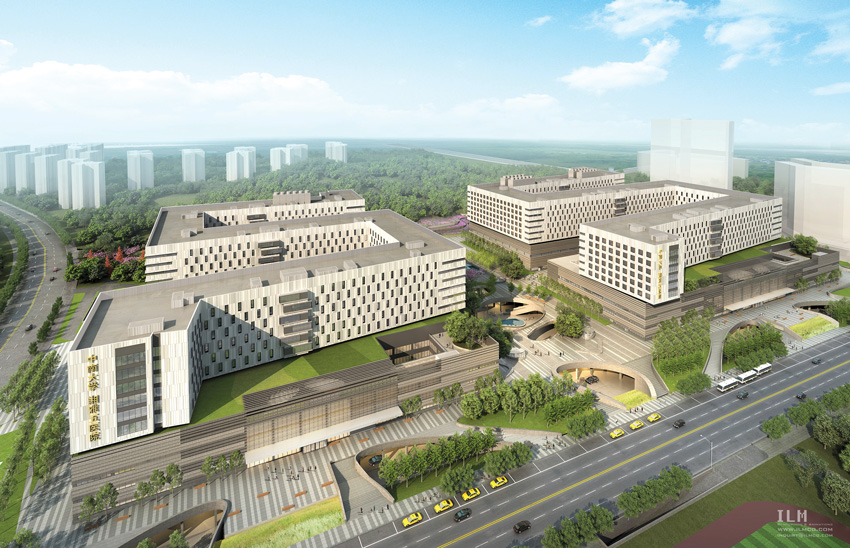
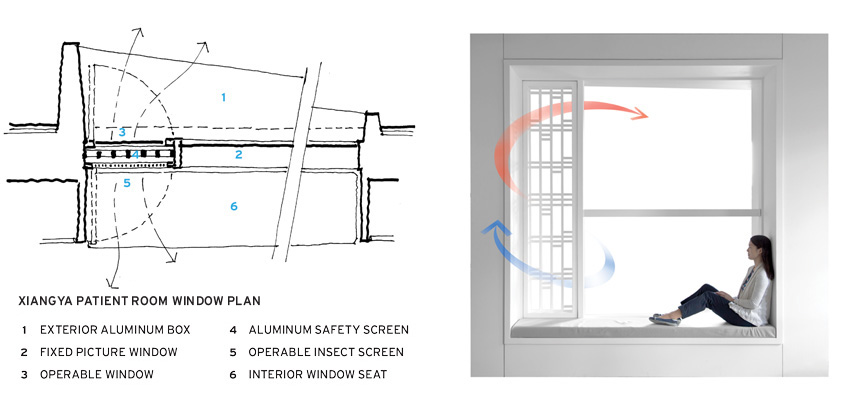
IMAGES: COURTESY PAYETTE
QUIET CORNER
The design for Fifth XiangYa Hospital in Changsha, China (top), includes operable windows (bottom, left and right) that rely on the stack effect to ventilate the patient rooms. The windows incorporate patterned screens, shading devices, and a bench.
Payette’s solution is to provide for safety and ventilation separately. A patterned aluminum screen, with openings sized to comply with the 4-inch safety maximum, will serve as a guard on the interior side of the window. This will free the window, sized tall enough to generate a stack effect, to open fully. The assembly will form part of a window frame and seat in each patient room. Outside, the frame projects to act as a shading device for the glass. For the patient, the window will provide fresh air and views to gardens, while the scale of the window box will offer a sense of intimacy in the large building. “It would be a hard sell in the U.S.,” says Menchaca. “Who’s going to clean the screen? Who’s going to open the window?” But for a client already used to operable windows and insect screens, these concerns don’t arise. Even so, Payette has designed the insect screen to swing inward for ease of cleaning both sides.
NTFGH and XiangYa are just two among many instances of naturally ventilated health-care facilities internationally, but North American examples are few and far between. A survey conducted by Payette of health-care architects, engineers, and owners in the U.S. suggests that the industry’s main concerns pertain to a perceived lack of infection control, the logistics of controllability, patient comfort, and added construction costs. Perceived advantages include a connection to the outdoors, resilience in the event of power failure, improved working conditions and patient care, and reduced operating costs.
Infection control is highest on the list of cited concerns. But proponents of natural ventilation in health-care environments say that these worries are based on a misunderstanding of where natural ventilation will be used. Certain areas are generally considered inappropriate for it, including operating rooms, the sterile core, procedure suites, interventional radiology and cardiology areas, airborne isolation rooms (unless separately exhausted), protective environments, and intensive care units. Outside the operating room, the most common hospital-acquired infections (HAI) are pneumonia, urinary tract, bloodstream, and gastrointestinal diseases, none of which are likely to be affected by ventilation systems. In fact, HAI rates in Europe, where natural ventilation is common, are no higher than those in the U.S.
Peace Island Medical Center, the 39,000-square-foot, two-story facility in Washington State, exemplifies North America’s baby-steps approach. Located in a climate where mild summers make natural ventilation a perfect fit, the facility, which opened in 2013, is “a very modest starter kit,” says Anne Schopf, partner and director of design at Seattle-based Mahlum Architects. “The accomplishment was huge, but the risk was also lower because of climate and project scale.”
With a goal of resilient health-care delivery on an island where power outages are common, the design team tailored the hospital’s environmental control systems to its program areas’ specific needs. In inpatient areas, which are intermittently or partially occupied, operable windows provide cooling and ventilation (supplemental fans prevent air changes from falling below code minimums); the outpatient clinic, which accounts for about a third of the building, uses the same setup as the inpatient areas, but with a more basic fan exhaust providing fewer air changes. Emergency and imaging departments are conditioned by mechanical means using a conventional variable air volume (VAV) system and ground-source heat pumps; the surgery is equipped with a dedicated fan-coil unit that can be shut down when the space is not in use. This design has enabled Peace Island to achieve an EUI of 87.7 kBtu per square foot per year (a typical hospital in the Pacific Northwest scores around 265).
After more than four years of operation, “I’d say the majority of users think [natural ventilation] is great,” says Ben Coon, regional construction project manager for PeaceHealth. But with only two or three inpatients admitted per day, he adds, the data pool is tiny.
Even for so small a facility in an ideal climate zone, however, obtaining Department of Health approval for operable windows wasn’t easy. Concerns included humidity, security, pollen and dust, infection control, staff controls, patient experience, and the durability of interior materials. Ultimately, PeaceHealth provided reassurance in the form of a memorandum, included with its building-permit application, describing the design provisions and operating policies by which each DoH-identified concern would be addressed.
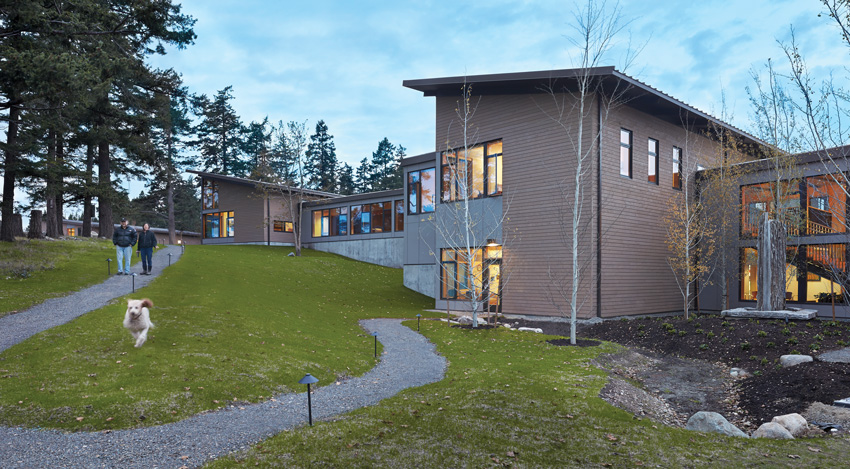
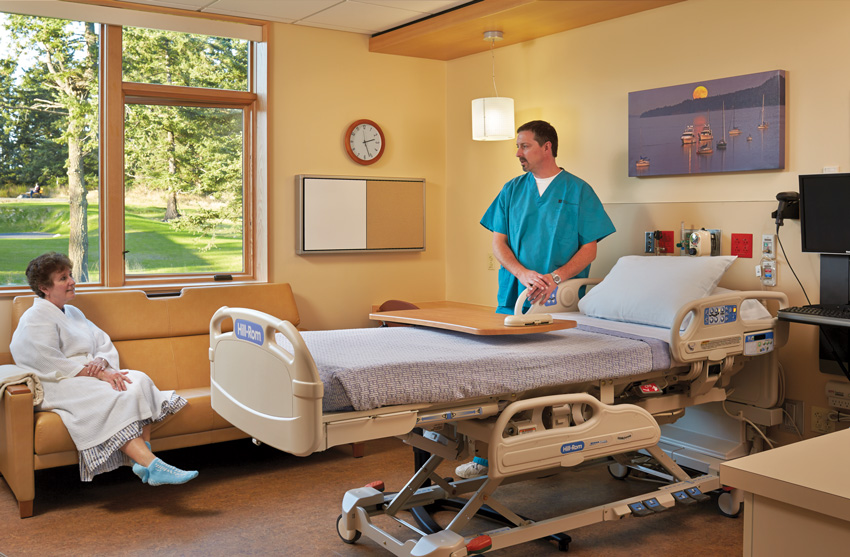
PHOTOGRAPHY: © BENJAMIN BENSCHNEIDER
STARTER KIT
The modest scale of the Peace Island Medical Center (top and bottom) in Washington State, along with the Pacific Northwest climate, made it the perfect candidate for natural ventilation.
“It comes down to liability,” says Coon, and, with operable windows an ideal rather than a necessity, “We probably would have given up.” But the design team persevered, and today the Peace Island Medical Center stands as a path-breaking solution for its circumstances.
That path may be about to open up. At this year’s ASHRAE annual conference, in Long Beach, California, Travis English presented the natural-ventilation task group’s position paper summarizing its two-year review of ASHRAE Standard 170: Ventilation of Health Care Facilities. If a design culture of mechanical ventilation is what makes North Americans leery of adopting natural ventilation for health care, Standard 170, which a number of jurisdictions have incorporated into their building codes, is what locks that design culture into industry practice. The standard’s provision that “all of the air provided to a space shall be filtered” and that “the entire minimum outdoor air changes per hour . . . shall meet the filtration requirements” may have been intended to apply only to mechanically supplied air, but Standard 170 is widely understood to preclude natural ventilation anywhere in a health-care facility.
The task group’s position paper calls for change, suggesting that natural ventilation should be allowed in most health-care spaces, except for operating rooms and other critical areas. Among the likely benefits, the paper identifies energy reduction and enhanced occupant satisfaction. It advises designers to fully consider space and climate appropriateness, acoustics, security, and outdoor air quality, and cautions that projects implementing natural ventilation should anticipate challenges, since many commissioning agents and air-balance providers in the United States are unfamiliar with natural-ventilation systems. “We’re going to look at that horse’s teeth pretty hard,” says English, speaking from a facility owner’s perspective, “but it should be something we have the choice to evaluate. It should be an option.”
Katharine Logan is a designer and writer focusing on design, sustainability, and well-being.
